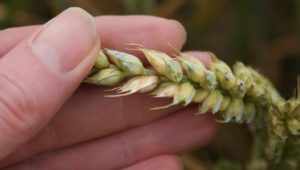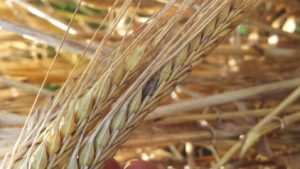Managing the risk of ear diseases in cereals
25 June 2018There are three grades of ear disease in cereals to worry about – those that can strip yield and cause food safety issues like fusarium, those that can strip yield like microdochium and those that are largely just unsightly like the sooty moulds.

A nice looking crop of Saffron but close inspections shows several brown and empty grain sites – yield losses though will be minimal at this level of infection.
Fusarium species are one of the key worries – they can cause direct yield losses by blocking the connection between each grain site and the main shoot but they can also produce mycotoxins which is where concerns about food safety come in. For wheat, it is obligatory to do a risk assessment for mycotoxins – which is available to down load from the AHDB website ( https://cereals.ahdb.org.uk/riskassessment). The risk assessment needs to be started before the crop is flowering so that decisions about ear sprays can be made based on the risk. Geographically, Scotland is classed as being at low risk, because many of these fusarium species are linked to warmer temperatures but we shouldn’t be complacent – they are found this far north. Another key driver of risk is trash – of which maize is particularly risky but is obviously not widely grown in Scotland. Azole fungicides are the key management tool in terms of ear sprays as they also manage the related species of Microdochium. Accurate records of rain fall over flowering and over grain ripening need to be kept as these are the main drivers of risk, accounting for almost 60% of the final risk score. Current warm sticky weather with thunder plumps are ideal for infection and flowering is the period of highest risk. Timing of fungicides is crucial and should ideally be within 48 hours of infection so in showery weather this will be early in flowering. Only if it is dry can the spray be delayed to later in flowering.
Microdochiums are common in Scotland as in general they enjoy slightly cooler conditions than fusariums and they have been very common in recent wet summers. They can still be damaging to yield but don’t produce mycotoxins. Sooty moulds can look bad in wet summers but will often thresh off leaving a clean looking sample so are seldom worth managing in their own right. Late season septoria management is often important at T3 in wheat which is why azoles at this timing yield well in trials. There has been a bit of interest in using SDHI fungicides on the ear in wheat to capitalise on their greening effects but the ear diseases are not a particular strength of this group of chemistry and there are other, cheaper ways to maximise greening. It’s also not ideal to give the SDHI chemistry an unnecessary exposure when we know there are emerging issues with resistance. We are really reliant on this group continuing to work to manage septoria so it is a shame to waste a hit where they aren’t really needed, especially at the end of the season when the septoria population that survives will move into the autumn crops.

Winter wheat with fusarium (seen as pinkish) on the ear and hints of sooty moulds infecting where flowers have dropped away
Barley is also susceptible to ear diseases with the additional worry that the ear is not a direct target of fungicides. Despite this worry, there is no additional yield benefit to directly treating the ear and there may well be strong reasons not to do so – for example because late applications of fungicides can affect the malting process and for many products is beyond label latest application dates in any event. Poorly filled ears are more susceptible to disease so earlier fungicides that retain green leaf and keep out ramularia and other diseases play their part.
Fiona Burnett (SRUC) for the Farm Advisory Service
Sign up to the FAS newsletter
Receive updates on news, events and publications from Scotland’s Farm Advisory Service


